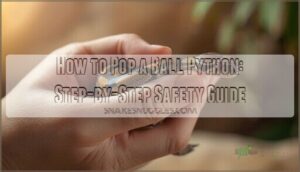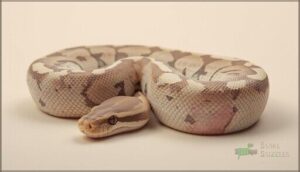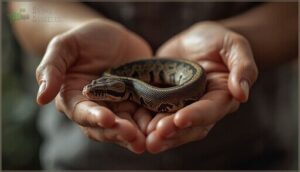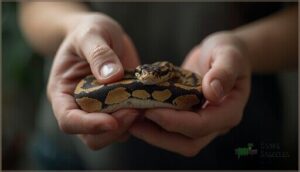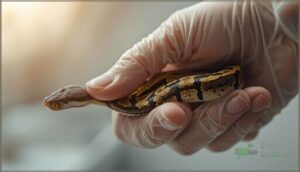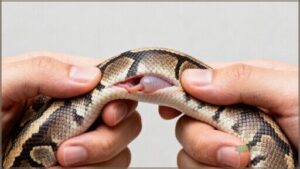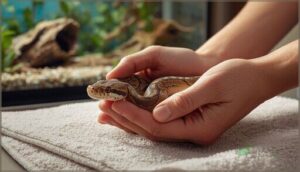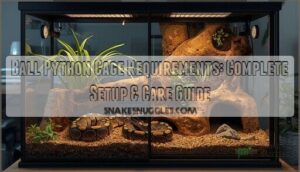This site is supported by our readers. We may earn a commission, at no cost to you, if you purchase through links.
The first time you hear someone mention “popping” a ball python, it might sound strange—even risky—but for keepers and breeders, this skill is as essential as reading a thermometer.
Early sex identification shapes breeding projects, helps prevent future surprises, and keeps your collection on track. Done correctly, popping is a straightforward process that lets you distinguish male from female hatchlings quickly and reliably.
Understanding how to pop a ball python safely means less guesswork and fewer mistakes—so whether you’re a new keeper or ready to level up your skills, clear guidance makes the difference.
Table Of Contents
- Key Takeaways
- What is Popping in Ball Pythons?
- Ball Python Anatomy Relevant to Popping
- Preparing to Pop a Ball Python
- Step-by-Step Guide to Popping a Ball Python
- Safety Precautions and Aftercare
- Frequently Asked Questions (FAQs)
- Can you pop a ball python?
- Is probing better than popping a ball python?
- How do ball pythons pop hemipenis?
- How to pick up a ball python?
- How do you hold a ball python?
- How do you stop a ball python from dangling?
- How do you pop a snake?
- Can you pop adult ball pythons?
- How do you unlatch a ball python?
- How can I help my ball python poop?
- Conclusion
Key Takeaways
- Popping is a hands-on method for sexing young ball pythons by gently everting hemipenes, best used on hatchlings under six months old and less than 200 grams.
- Proper restraint, hand positioning, and minimal pressure are essential to avoid injuring the snake during the popping process.
- Both popping and probing accurately reveal a ball python’s sex, but popping is safer for juveniles while probing suits adult snakes.
- If you see swelling, bleeding, or unusual behavior after popping, stop immediately and consult a reptile veterinarian to prevent long-term harm.
What is Popping in Ball Pythons?
Popping is a hands-on technique used to determine whether your ball python is male or female. It involves applying gentle pressure near the tail base to reveal the presence or absence of hemipenes, the male reproductive organs.
Understanding why you’d choose popping over other methods, how it differs from probing, and when it’s the right approach will help you make informed decisions about sexing your snake.
Purpose of Popping for Sexing
Popping has one clear goal: sex determination in your ball python. When performed correctly on hatchlings, this method reveals hemipenes in about 95% of males, letting you identify gender weeks before other techniques become practical.
Breeders rely on popping to sort stock quickly, plan breeding strategies, and allocate resources efficiently—often within 2–4 weeks post-hatch, supporting better hatchling care and snake welfare from the start.
However, amateurs shouldn’t attempt it, as incorrect popping can harm the snake.
Differences Between Popping and Probing
While popping relies on gentle pressure to evert hemipenes in hatchlings, probing uses a slender metal rod inserted into the cloaca—reaching 6-10 scales deep in males versus 2-4 in females. Both ball python sexing methods boast 99% accuracy when done right, but injury risks differ: probing suits adults better, while popping works best on young snakes under 80 grams, raising ethical considerations about technique evolution and age suitability.
In contrast, probing reticulated pythons boasts 100% accuracy.
When to Use The Popping Method
Although both sexing techniques have merit, you’ll want to reach for popping in specific scenarios. This rapid assessment method shines when determining snake sex in hatchling sexing operations, especially during breeding programs where early identification of male ball pythons matters for inventory planning. Cost constraints often make popping the practical choice over genetic testing, particularly when sorting large clutches.
- Best for ball pythons under six months old and weighing less than 200 grams
- Ideal when sorting multiple hatchlings quickly in breeding programs
- Useful when genetic sexing isn’t accessible due to cost or time limitations
- Preferred for initial rapid assessment before confirming with probing later
Ball Python Anatomy Relevant to Popping
Before you attempt popping, you need to know what you’re looking for inside your ball python’s body. The key structures are the cloaca and hemipenes, which differ between males and females.
Let’s break down the anatomy so you can confidently identify what you’re working with.
Understanding The Cloaca and Hemipenes
Before you attempt popping for sexing your ball python, you need to understand the anatomy involved. The cloaca functions as the single opening for digestive, reproductive, and urinary systems in all ball pythons.
Males possess paired hemipenes—eversible organs stored inside the tail base—that develop embryonically as lateral swellings. These hemipenes invert into pockets within the cloaca when not in use, making popping possible.
Male Vs. Female Ball Python Anatomy
Sexual dimorphism in ball pythons becomes apparent when you examine their reproductive organs and anatomical features. Males have a noticeably thicker tail base with a bulge housing the hemipenes, while females display thinner tails with minimal tapering.
Male cloacal differences include larger pelvic spurs near the vent, compared to the smaller spurs found in female snakes—though this characteristic varies among individual ball pythons.
Preparing to Pop a Ball Python
Before you attempt popping, you need to set yourself up for success. This means choosing the right snake, getting your supplies ready, and creating the kind of environment where both you and your ball python can stay calm.
Let’s walk through each preparation step to make sure you’re doing this safely and effectively.
Selecting The Right Age and Size
Your ball python’s age and weight directly determine popping success and safety. Stick to these guidelines:
- Ideal age: Under 12 months old, preferably 0-3 months when hatchlings weigh 60-150 grams
- Weight limits: Keep attempts below 300 grams—larger snakes need probing alternative methods
- Hatchling growth: They double their mass in three months, so timing matters
- Injury risks: Older snakes have stronger muscle control, increasing prolapse and tissue damage likelihood
Proper animal sexing methods start with appropriate sizing.
Gathering Necessary Supplies
You’ll need minimal but essential sanitary equipment before starting. First, wash your hands with antibacterial soap, then put on surgical gloves—they prevent contamination and keep your ball python comfortable.
Lay out a soft, clean towel for secure restraining during handling. Keep petroleum jelly nearby as lubricant if needed near the vent area.
Ensuring Snake Health and Safety
Before popping, check your ball python for signs of illness or stress. Avoid handling for 24–48 hours after feeding to prevent regurgitation. Don’t attempt this during shedding cycles when visual impairment increases stress.
Look for clear eyes, smooth scales, and normal behavior. If your snake shows lethargy, refuses food, or displays respiratory symptoms like wheezing, postpone the procedure and consult a veterinarian experienced in reptile health issues first.
Setting Up a Calm Environment
Your ball python can sense tension just like you sense a storm coming. Choose a quiet room away from loud noises, bright lights, and pets.
Maintain proper temperature control (80–85°F ambient) and humidity management (40–60%) before handling. Your enclosure design should already include secure hides and environmental enrichment.
This calm setup facilitates safe reptile handling and reduces stress during the popping procedure.
Step-by-Step Guide to Popping a Ball Python
Popping a ball python isn’t something you should rush into without understanding the exact steps. The technique demands precision, a steady hand, and respect for your snake’s comfort throughout the process.
Here’s how to perform the procedure safely from start to finish.
Safely Restraining Your Ball Python
Proper restraint sets the foundation for safe snake sexing methods—without it, you risk injury to both yourself and your ball python. Your goal is gentle support, not forceful control.
Follow these restraint methods for effective ball python care:
- Support the body evenly across at least two points, avoiding any pressure on the neck or head region
- Keep handling sessions under 15 minutes to minimize stress responses and defensive behaviors
- Watch for stress signals like hissing, S-shaped posturing, or balling up—stop immediately if these appear
Proper Hand Positioning Techniques
Once your snake is secure, thumb placement becomes the next critical step. Position your thumb directly above the vent—centered, not off to one side—while your index finger steadies the tail’s underside. Keep your fingers aligned parallel to the tail’s long axis, staying 2–4 millimeters behind the ventral scale.
This symmetrical setup protects delicate scales and ensures proper hand motion for accurate male sexing results.
Applying Correct Pressure to The Tail Base
With your hand in place, roll your thumb forward using steady pressure—less than 1.5 Newtons—from the tail base toward the cloaca. Don’t squeeze or jerk. This gentle rolling motion coaxes hemipene eversion in males without causing injury.
Follow these safety protocols for proper pressure application:
- Apply smooth, rolling motion—never sudden squeezing
- Use minimal force to prevent hemipenal prolapse
- Stop immediately if the snake tenses its tail
- Complete the procedure within 10 seconds
- Watch for visual swelling or redness afterward
Your thumb shouldn’t create visible tail deformation. If it does, you’re pressing too hard.
Recognizing Male and Female Indicators
Once you’ve applied pressure, interpreting what you see determines sex. Male ball pythons show hemipene eversion—two small, pink, fleshy structures emerging from either side of the cloaca.
This hemipene eversion confirms male gender identification with over 95% accuracy in juveniles. Females reveal nothing; the anatomy comparison shows smooth tissue with no protrusion, indicating reproductive differences between sexes.
What to Do if Unsure of The Results
Sometimes the signs aren’t clear—incomplete eversion or minimal tissue response leaves you guessing. Uncertain results happen in 7% of male hatchlings due to resistance or technique.
Don’t repeat popping immediately; tissue damage risks jump to 6% with multiple attempts. Wait one week minimum between tests.
If doubt persists, seek professional consultation or genetic confirmation through shed testing—it’s 99.9% accurate and eliminates sexing errors completely.
Safety Precautions and Aftercare
Popping your ball python safely doesn’t end the moment you identify its sex. What happens after the procedure matters just as much as the technique itself.
Let’s cover the key safety measures and aftercare steps you need to follow to keep your snake healthy and stress-free.
Preventing Injury and Stress
Preventing injury during popping starts with Safe Handling and Gentle Techniques that prioritize Snake Welfare. Your Ball Python depends on you to minimize physical trauma and stress reduction throughout the process.
Key principles for Injury Prevention:
- Support the entire body during restraint to prevent musculoskeletal damage
- Use slow, deliberate movements when positioning your hands near the vent and cloaca
- Apply minimal pressure during popping—excessive force causes tissue injury
- Stop immediately if your snake shows defensive behaviors or resistance
Monitoring for Health Issues Post-Popping
Regular observation is essential after popping your Ball Python, as early Prolapse Detection, Respiratory Distress, and Infection Signs are key to timely intervention. Watch for vent swelling, labored breathing, loss of appetite—known as Anorexia Monitoring—and trouble shedding.
Any unusual posture or persistent soaking could signal underlying Snake Health or general Reptile Health Issues needing further care.
When to Seek Professional Assistance
How soon should you call a vet for your Ball Python after attempting popping? If you notice bleeding, swelling, or signs of pain—like rapid breathing—don’t wait. Unsafe practices by amateurs often lead to lasting damage. Prioritize professional consultation when:
- Injury indicators appear after popping.
- Amateur risks become clear.
- Long-term effects threaten your snake’s health.
Recognizing Signs of Improper Popping
Picture your Ball Python hiding for days, refusing food, or twitching its tail—these aren’t quirks; they’re red flags after popping. Cloacal Prolapse, Scale Damage around the vent, sudden Lethargy Signs, and even Refusal Feeding hint at improper animal sexing.
If your ball python hides, refuses food, or twitches its tail after popping, these are critical warning signs of improper handling
Don’t ignore persistent tail twitching or swelling. Weaving careful aftercare into your routine can mean everything.
Frequently Asked Questions (FAQs)
Can you pop a ball python?
You can pop a Ball Python, but it isn’t something to take lightly. Even breeders debate its safety.
Handling experience, ethical considerations, and popping legality all matter, and alternatives like probing offer another route for checking vent anatomy.
Is probing better than popping a ball python?
For most snake breeders, probing offers higher accuracy and lower injury risks, especially for adults, while popping is age-suited to young snakes. Both animal sexing techniques demand skill and ethical consideration to avoid harming the animal.
How do ball pythons pop hemipenis?
Much like a concealed drawbridge, the hemipenes remain hidden until eversion is needed.
Muscle relaxation combines with hydrodynamic pressure and specific genetic patterning from embryonic development to allow popping, forcing these paired organs from the vent.
How to pick up a ball python?
Use a safe grip: support both the front and back third of the ball python. Avoid lifting by the tail or making sudden moves.
Handle only a few times a week, watch for stress signs, and always prioritize bite prevention.
How do you hold a ball python?
Imagine your snake as royalty—don’t snatch, simply provide proper support along the body. Gentle handling frequency and calm environmental considerations help prevent stress.
Recognize stress signals; injury statistics drop with careful animal care and maintenance, especially near the vent.
How do you stop a ball python from dangling?
Always provide secure grip and full body support, especially near the vent and midsection. Proper handling frequency helps reduce stress and injury prevention.
Never dangle, as male and female snakes both risk harm if unsupported during popping.
How do you pop a snake?
To pop a snake, gently secure its body, locate the cloaca or vent, and apply careful pressure near the base of the tail.
Handler experience is critical—improper popping risks long-term effects or injury. Consider ethical alternatives.
Can you pop adult ball pythons?
Much like using a payphone in the smartphone era, popping adult ball pythons is possible but much less effective and far riskier.
Adult popping safety concerns, size limitations, and injury risks mean alternative methods—like probing—work better.
How do you unlatch a ball python?
When a ball python latches, bite force can make removal tricky. For stress reduction, gently pour cold water over its face or use a credit card to disengage.
Preventative handling and quick injury assessment limit risk after dislodging.
How can I help my ball python poop?
To help your snake poop, offer a warm water soak for hydration, adjust humidity for digestive ease, and clean the enclosure regularly.
Address the cloaca and vent area gently; for persistent constipation, herpetology-based dietary adjustments or veterinary laxatives may help.
Conclusion
Investigate the truth of a theory: experience is your clearest teacher. Learning how to pop a ball python isn’t just a technical checklist—it’s the difference between confident care and second-guessing every hatchling.
With steady hands, you’re spotting hemipenes or spurs, you’re validating every stage of your animal’s health and future. Mastery comes from patience, practice, and attention. Your collection deserves that certainty, and each snake benefits from your diligence every step of the way.
- https://www.reptifiles.com/ball-python-care-guide/ball-python-diseases-health/ball-python-burn/
- https://reptifiles.com/ball-python-care-guide/ball-python-diseases-health/ball-python-sexing/
- https://www.youtube.com/watch?v=C-q-zAL6zpg
- https://www.facebook.com/groups/967708664967231/posts/1246638867074208/
- https://ball-pythons.net/forums/showthread.php?202376-Probing-vs-Popping-accuracy

